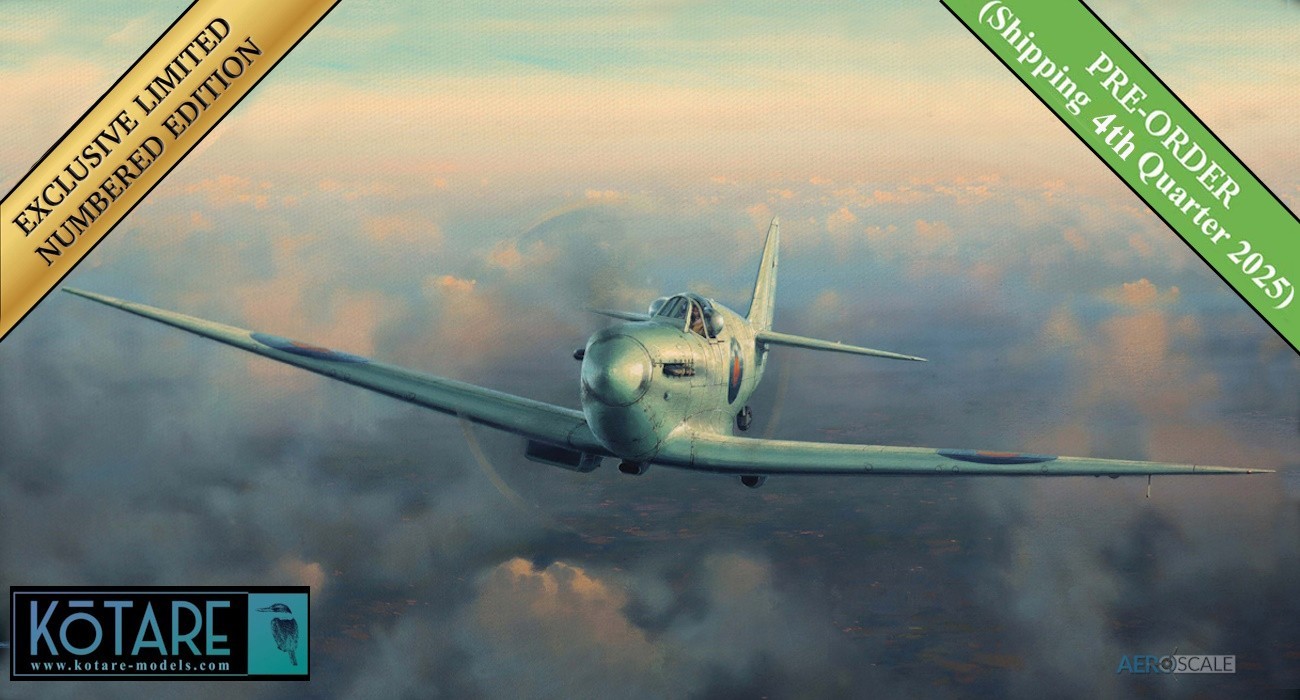
Preface
This book is particularly meaningful to me on a personal level, and I am grateful to the author for writing it. As a young freightdog pilot for an air cargo company, I logged around 600 hours in DC-3/C-47s. One of the captains I frequently flew with was Mr. Stan Bagnall, a fine gentleman and exceptional airman who had been a Fifth Air Force C-47 pilot over New Guinea and the Philippines. Over the decades I have forgotten which Troop Carrier Squadron he was in, although it must of been the 39th, 40th, 41st or 46th TCS, which constituted the 317th Troop Carrier Group. This I figured out because Stan was the pilot-in-command of the lead aircraft that dropped paratroopers on Corregidor in 1945. Stan not only flew C-47s, he volunteered for functional flight checks (test flights after maintenance) and checked himself out in a variety of fighters and bombers. He was tapped to bring a Douglas A-26 Intruder east from the West Coast to its new owner. A spry healthy man, even in his late 60s or early 70s when I flew with him, he would vault himself up onto the wing of a C-47/DC-3 without a ladder. Post-war he was one of the early pilots for Delta, and c.1968 he "retired" to become a flight instructor and a FAA check airman. Stan loved to teach and, unlike some captains, did not treat low-time new hires as imbeciles. He was willing to share his knowledge gained since the early days of the airline boom, some of which I still utilize today. Twenty years ago he earned the FAA Master Pilot Award.
Stan was a class act and it was a privilege to fly with him. We had some adventures. You can watch an hour and a half interview with him from him at the link in the comments. Looking at the photos and artwork in this book, I can not help but wonder which of those C-47s he had missions in.
Introduction
Pacific Profiles Volume 7 Allied Transports: Douglas C-47 series South & Southwest Pacific 1942-1945 is a title of the Pacific Profiles range of books from Avonmore Books, authored by Michael Claringbould. This 160-page softcover book is catalogued with ISBN: 9780645246919.
C-47s were essential everywhere to the Allied war effort. General Eisenhower declared it as one of the five most important weapons of World War II! Every aircraft type seems to have myths and legends and misunderstandings of one sort or another, even the plodding "Gooney Bird", as C-47s were known. Fortunately, survivors of the era have emerged with a growing amount of surviving original documents and relics. An increasing cadre of modelers and researchers privy to such resources, capable of reading and understanding them, and dedicated to analyzing actual colors and markings, are establishing a more complete portrait of the subjects. This book explores the record and includes new insignia and camouflage revelations.
Avonmore introduces the books as:
Volume Seven covers the Douglas C-47, including numerous derivatives such as the C-53, R4D and DC-3. This was the most universal aircraft type to appear in the South Pacific and was deployed from day one to the cessation of hostilities. It was utilised by every military organisation including eighteen Fifth and Thirteenth Air Force USAAF squadrons, and also by the USN, USMC, RAAF, RNZAF, RAF and Dutch Air Force.
Most profiles are presented for the first time, alongside a full explanation of the markings. Frequent trading of airframes between units resulted in wide-ranging heraldry, unit markings and nose art. In particular until now there has been a paucity of information about the markings of Thirteenth Air Force C-47s and USMC R4Ds, a gap largely filled by this volume.
This volume illustrates the development of unit markings from the first commandeered DC-3 airliners in Australia through to the RNZAF C-47s used in the last days of the Pacific War in the Solomons. The profiles are accompanied by unit histories and photos. A wide range of reference material has been consulted including photos, colour movies, official records, diaries and information from wreck sites.
The author, Michael Claringbould, is world-renown for his expertise on the Pacific air war. Never before have such meticulous colour profiles of the C-47 series been illustrated with such detailed and accurate markings.
Mr. Claringbould has authored more than 20 other titles. Most concern the air war in the South Pacific. Including an as of yet unpublished forthcoming subject, his series Pacific Profiles currently offers 12 titles, focusing on Allied and Japanese fighters, bombers, transports and miscellaneous types, and Japanese seaplanes. You can view this book on the company website here: Pacific Profiles Volume Seven Allied Transports: Douglas C-47 series South & Southwest Pacific 1942-1945.
The seeds for Mr. Claringbould’s passion were planted in 1976 when, "...an irritable priest at Alexishafen, on New Guinea's north coast, reluctantly allowed me to scour and photograph Japanese aircraft wrecks on the mission's land," where he found a Ki-43-II. "Curiosity caused me to start collecting all material on this arcane subject, but it was frustrating. Few publications, including Japanese-language ones, agreed on interpretations..." Thus he began decades of research to learn and clarify, including finding wreckage of downed aircraft.
C-47s flew prosaic "trash hauler" flights in quiet areas, risked operations from frontline airfields, and undertook dramatic combat operations. We will read about that in this book as we learn about the color and markings of this noble transport, a few hundred of which continue to fly today.
Content
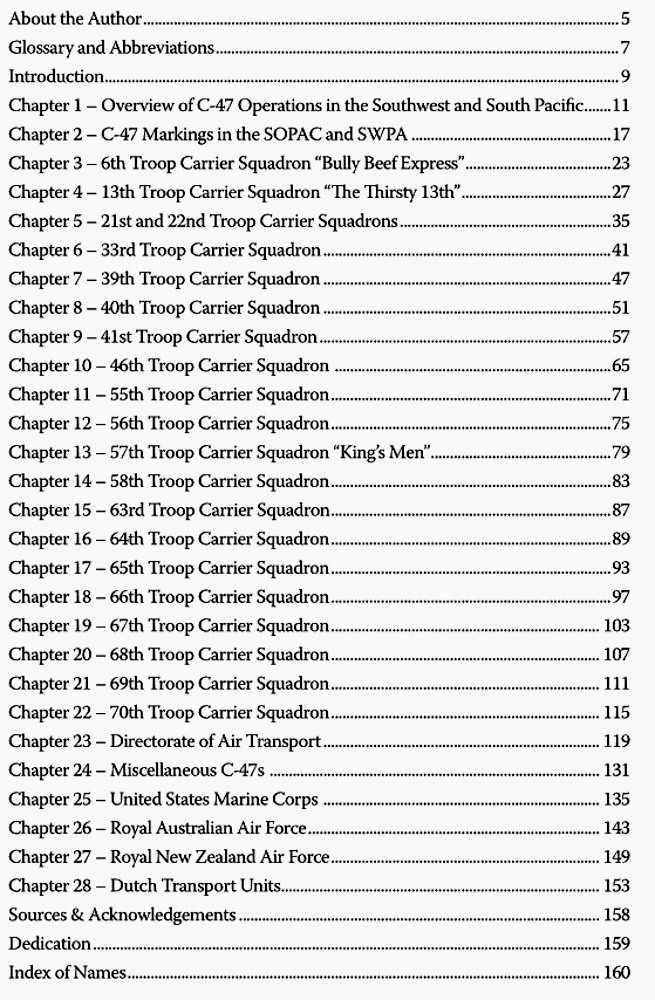
These chapters are abundantly illustrated with photographs and artwork. After a brief introduction about the author, the book presents five pages of the history of the C-47 in the South & Southwest Pacific, including maps, a glossary & abbreviations, and the introduction to the C-47. Glossary & Abbreviations presents common terms and usage, i.e, TCS= Troop Carrier Squadron. The first two chapters are Overview of C-47 Operations in the Southwest and South Pacific and C-47 Markings in the SOPAC and SWPA, immersing us into the subject of tactical and technical markings. We learn that losses were not as we believed, the origins of Air Transport Command (ATC), other aircraft involved, miscellaneous units, and several other important subchapters. The joys of flying in tropical weather patterns is discussed. General markings and camouflage, and many different serial number/call numbers, national insignia changes are covered.
Chapters 3-28 introduces us to the Troop Carrier Squadrons (TCS). Pacific Profiles is a wealth of information and each chapter begins with a history of the unit including (when known):
· Commanding officers
· Establishment location and training areas if pertinent
· Base of arrival/operations in-theater
· Aircraft unit codes
· Aircraft manufacturer numbers
· Date of commencement of operations
· Combat
· Losses
· Transfers
· Re-equipping
When available, each unit history includes the record of losses of pilots and aircraft (with name and cause when known).
Photographs, Artwork and Graphics
If you have read other Pacific Profile books, you know they feature an impressive gallery of black-and-white and even color photos to support the text. This books contains several original color photos. They span the gamut of professionally exposed and developed images to amateur pictures. Some are stills taken from motion pictures. Many show damaged aircraft. The author chose excellent images that visually confirm insignias and odd camouflage patterns. I am amazed by many of the images.
Perhaps the most impressive part of the book is the original color artwork by the author of select aircraft. As previously mentioned, each profile is supported by photos and/or documentation. The publisher writes:
Each profile has been produced by citing wide-ranging reference material, including official squadron records, colour movies, maintenance logs, diaries, wreck site inspections and thousands of photos including colour slides.
As in the artist’s other books, weathering and wear is illustrated. His experience as a pilot allows him to capture the atmospherics of the in-flight illustrations.
Many profiles are authenticated with a wartime photograph of the aircraft. Most of the profiles include a a line or two of narrative of the history of the aircraft, some consist of a small paragraph. Many illustrations are accompanied by photographs of the subject aircraft. Some are poignant such as a 1979 recovery team at the wreckage site of 57th TCS C-47 X163 Shakes All Over.
Artwork
Like the photographs, the illustrations are a treasure trove for modelers. While the academic and technical research is the brain of this book, perhaps the most impressive part is the original color artwork that visually spotlights what the text imparts. The author richly illustrates select C-47s – 100 profiles - and dozens of supporting illustrations. I am amazed at some of the unique markings, insignia, and bare metal finishes. Most Gooney Birds were olive drab/neutral gray although some in medium green/forest green are shown. Depicting the operations of C-47s is a map of the combat area showing C-47 bases. Many profiles are authenticated with a wartime photograph of the aircraft. A sampling are C-47s painted with:
Nose art
Unit markings
Directorate of Air Transport (DAT) tail codes
Personal decorations
The following is the breakdown of illustrations per section and unit.
6th Troop Carrier Squadron "Bully Beef Express": four C-47 profiles and four detailed parts of the aircraft, plus the unit insignia.
13th Troop Carrier Squadron "The Thirsty 13th": eight C-47 profiles; nine close-ups of markings; unit insignia.
21th and 22nd Troop Carrier Squadrons: four C-47 profiles; four close-ups of markings; two unit insignia.
33rd Troop Carrier Squadron: six profiles; six close-ups of markings; unit insignia.
39th Troop Carrier Squadron: two profiles; two close-ups of markings; unit insignia.
40th Troop Carrier Squadron: four profiles; four close-ups of markings.
41st Troop Carrier Squadron: eight profiles; eight close-ups of markings; unit insignia.46th Troop Carrier Squadron: four profiles; four close-ups of markings; unit insignia.
55th Troop Carrier Squadron: two profiles; three close-ups of markings.
56th Troop Carrier Squadron:two profiles; unit insignia.
57th Troop Carrier Squadron "King's Men": one profile; one close-ups of markings; unit insignia.
58th Troop Carrier Squadron: three profiles; two close-ups of markings.
63rd Troop Carrier Squadron: two profiles; a close-up of markings; unit insignia.
64th Troop Carrier Squadron: two profiles; four close-ups of markings; unit insignia.
65th Troop Carrier Squadron: two profiles and a close-ups of marking.
66th Troop Carrier Squadron: four profiles; four close-ups of markings; unit insignia.
67th Troop Carrier Squadron: four profiles; four close-ups of markings; unit insignia.
68th Troop Carrier Squadron: two profiles; three close-ups of markings.
69th Troop Carrier Squadron: two profiles; unit insignia.
70th Troop Carrier Squadron: two profiles; unit insignia.
Directorate of Air Transport: 12 profiles; eight close-ups of markings.
Miscellaneous C-47s: four profiles; three close-ups of markings.
United States Marine Corps: six profiles.
Royal Australian Air Force: four profiles.
Royal New Zealand Air Force: two profiles and a close-up of markings.
Dutch Transport Units: four profiles; two close-ups of markings.
Aside from the airplanes, modelers will find a wealth of source material for airfield paraphernalia to create and detail dioramas. Other artwork includes:
Regional Transport Hubs, SWPA & SOPAC, 1942-1944.
Frontline Airfields, SWPA & SOPAC Theaters, 1942-1944.
Port Moresby airfield complex.
Transport Squadrons, Command Structure SOPAC & SWPA, 1942-45, listing four groups of the Fifth Air Force, and four groups of the Thirteenth Air Force.
Unique stencil style of serial numbers.
Squadron Numbers, US Marine & USAAF Transport Squadrons, South & SW Pacific 1942-45.
Action scene of a C-47 departing a Port Moresby airfield complex.
Action scene of a C-47 enroute to Espirito Santo from Guadalcanal.
Those graphics reinforce the rest of the book.
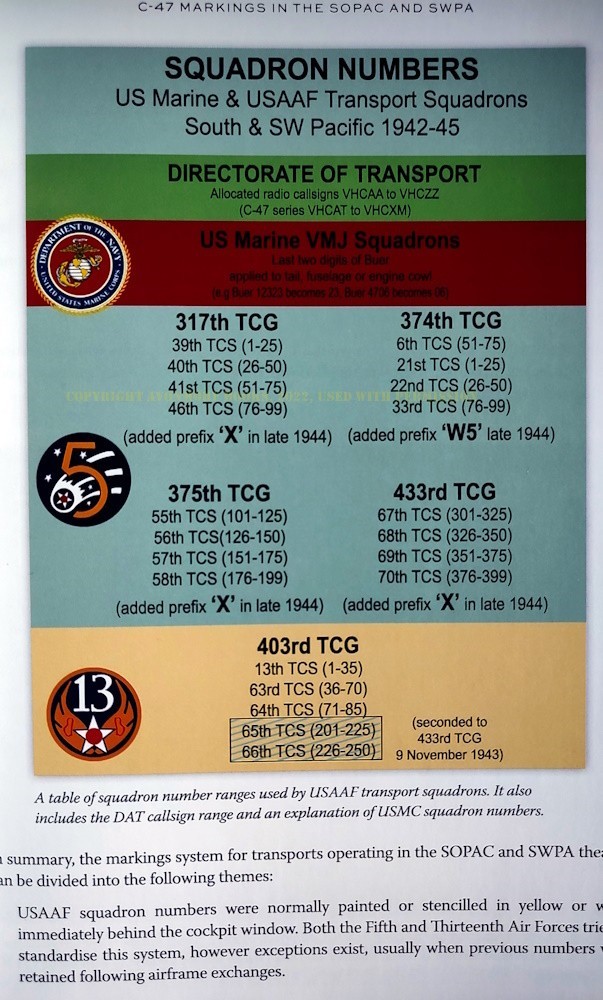
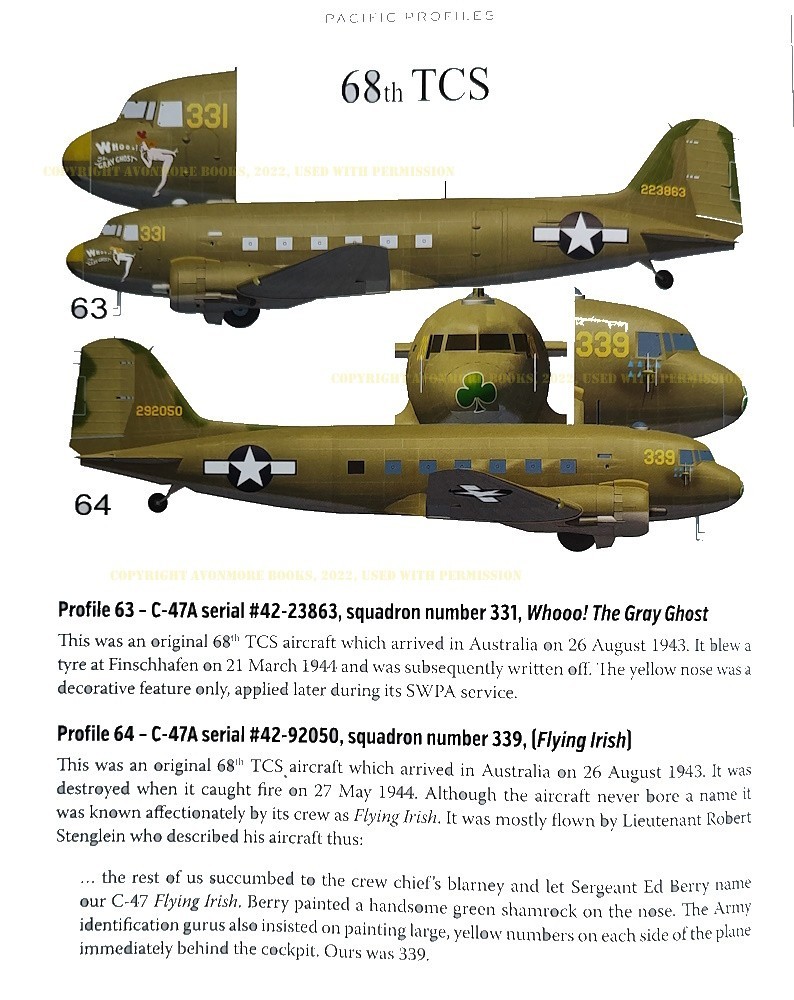
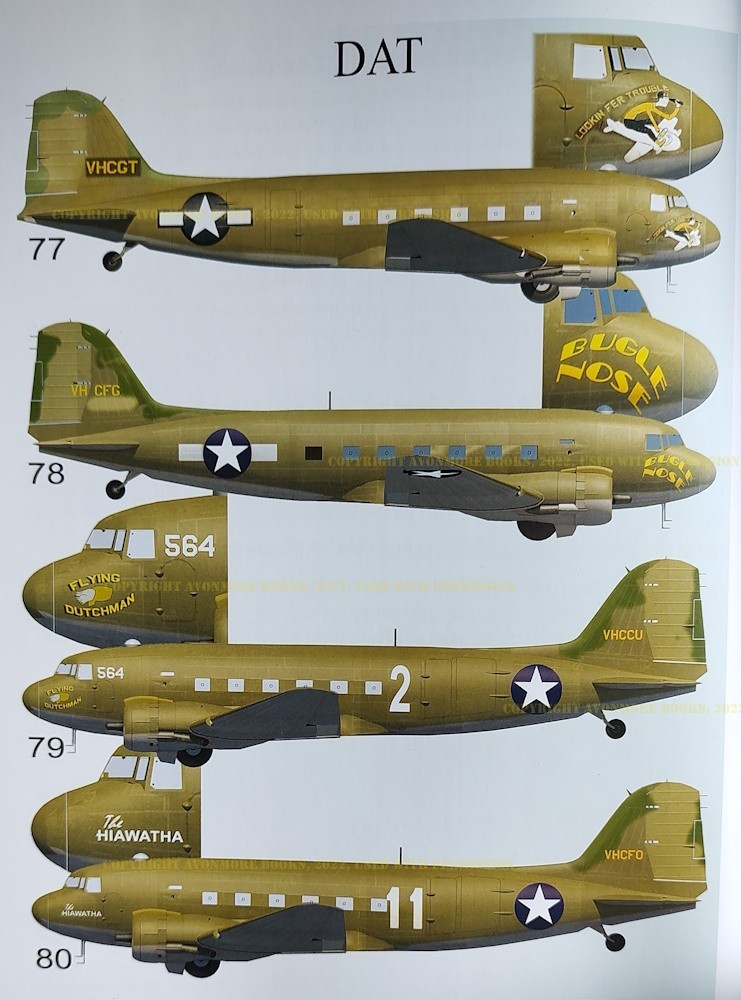

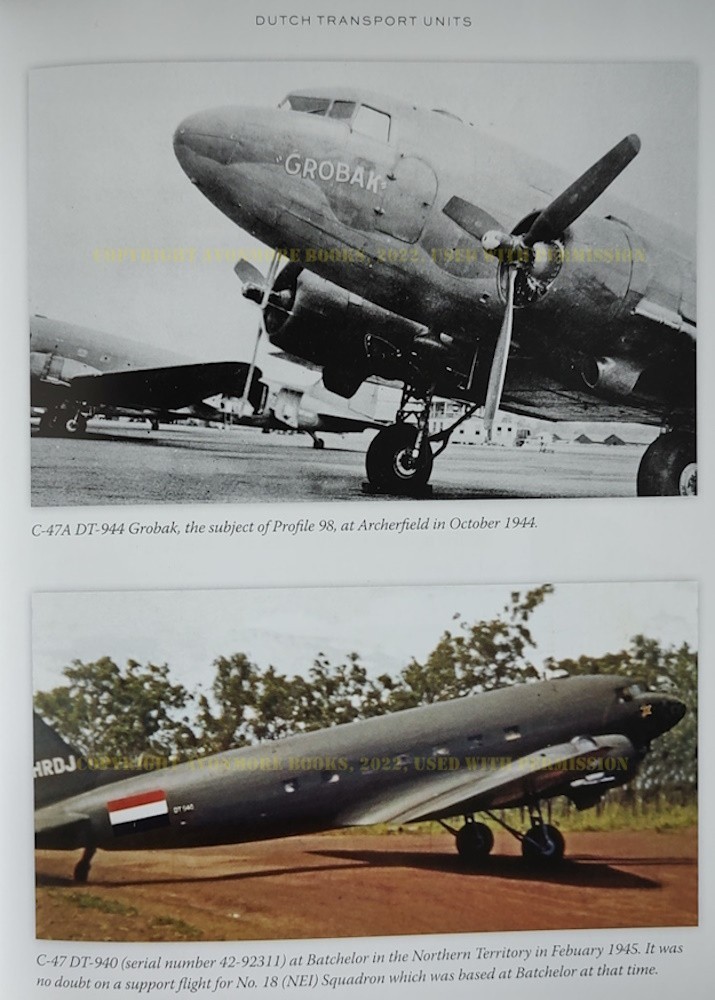
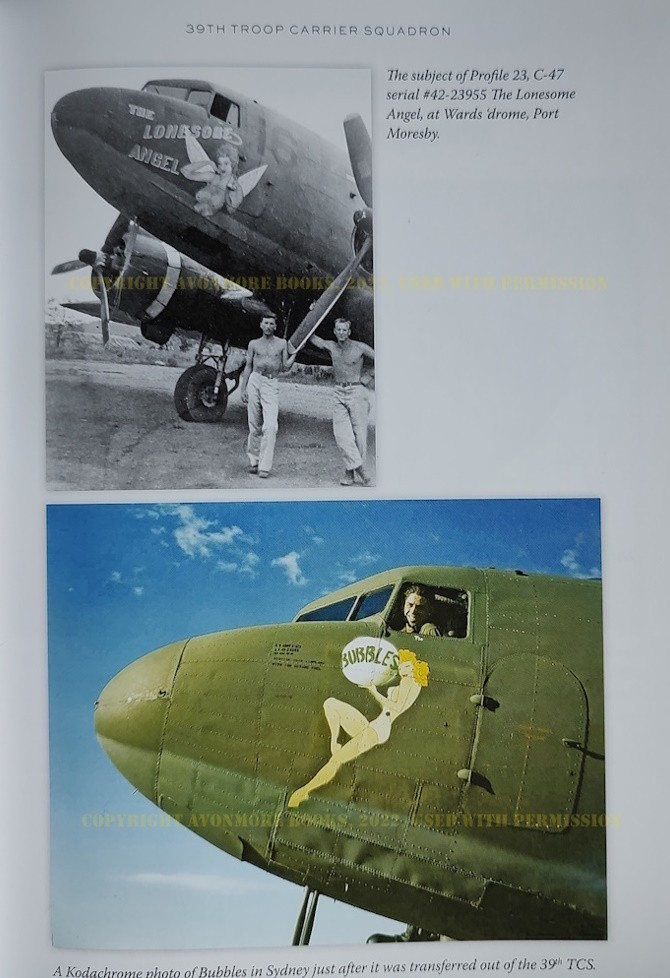
Conclusion
Pacific Profiles Volume 7 Allied Transports: Douglas C-47 series South & Southwest Pacific 1942-1945 is an exceptional book for enthusiasts and modelers of the C-47, Fifth Air Force or Thirteenth Air Force transports, and the South and Southwest Pacific air war. Full of amazing photographs and detail-rich artwork supporting the text of remarkable research, Avonmore Books should be proud of Mr. Claringbould's book. Fans of the C-47 should enjoy the variety of finishes and markings seen between USAAF, USMC, and Commonwealth C-47s, and I think this book will make an excellent addition to anyone's SWPA air war collection.
Certainly recommended.
Please remember to mention to vendors and Avonmore Books that you saw this product here - on AEROSCALE.



















